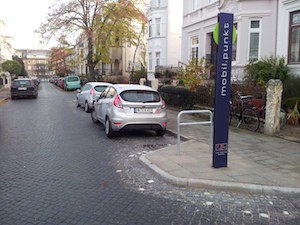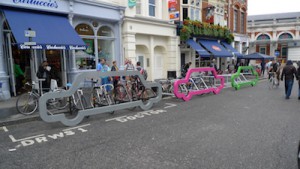Why Car-Sharers Need Fewer Cars
By Friso Metz, Advier, NL
####Car-sharing: paying per kilometer
The idea behind auto parts is that many cars stand still for a great part of the day. A pity actually, because for many households buying a car is a huge investment. For people who drive little but occasionally need a car, car-sharing offers a solution. They can reserve a car and pay for the times they use it.

Source: Freie Hansestadt Bremen, “mobil.punkt” Car-Sharing Station in Residential Neighbourhood
Driving is expensive, but the costs are quite invisible: the car has been paid for and the insurance and tax deducted automatically on a monthly (or annual) basis. If you do not have to fill up, you do not really notice that owning a car costs money whether or not you drive it.
In many cases the car is parked just outside of your house for flat. By that the car soon becomes the default option when you want to move somewhere.
For car-sharers, it’s the other way round. Car-sharers pay per ride. The cost of that one drive they see, and it becomes clear that driving is expensive. Moreover, use of a car-sharing requires a conscious act: in most cases you need to book the vehicle and the car may not be just outside your door. Using a shared car, therefore, requires a conscious decision about which mode of transport is the most effective and convenient to use at the moment. Because of the visibility of the costs, car-sharers will consider whether they really need to use a car. Public transport is often cheaper (especially if you already have a public transport subscription). And for shorter trips, cycling and walking are more obvious convenient choices.
For car-sharers, the car is not the default option, but just one of the options, if not the last option.
####Car-sharers plan better
Car-sharers are, therefore, environmentally-friendly travelers, who plan their journeys better and combine various forms of transport.

Source: cyclehoop
In that way, car-sharing contributes to a shift to other, more sustainable travel patterns. Many mobility management solutions help to reduce car use. Car-sharing is one of the few measures that demonstrably leads to less car ownership (9 to 13 fewer cars for traditional, station-based car-sharing). And the good news is that car-sharing doesn’t require governments to restrict car use or to decide on often resisted push measures like road pricing or paid parking.
Benefits of car-sharing depend on former behaviour
People who join car-sharing may have a different starting point:
1. They get rid of their second (or third) car. A car will be available in the household, but this vehicle has to be used more efficiently by the members of the household.
2. They sell the only vehicle they own.
3. They postpone or waive the purchase of a (second) car.
4. They do not own a car and do not want to buy one, but they do occasionally like or need to have access to a car.
Only for the fourth group does car-sharing lead to more car use. Various studies have pointed out that it is a small group that takes trips by car only occasionally. For the people who decide not to purchase a car, a positive effect is very likely: if they were to buy a car, then they would most probably use it more often. The real extent of this effect can be difficult to measure. Broadly speaking, the positive effects of car-sharing are greater than the negative effects.
Car-sharing: a game changer
Car-sharing contributes to solutions for problems in both cities and rural areas. Car-sharing is not an isolated issue: it is a part of a wide range of solutions. Car-sharers make conscious decisions about the use of the car. Using a car is no automatism but requires a conscious act. And because the actual costs of a trip by car are visible, car-sharing users are more likely to only take a car when other modes of transport do not meet their needs.
Car-sharing may seem a modest solution but it is a game changer, a key in the shift from car ownership to car use. Car-sharing namely leads to an increase in walking, cycling and public transport use. It also influences the use of other forms of transport such as taxis and rental cars. That means fewer car trips and more trips with sustainable transport.
Car-sharing unties the knot between car use and car ownership. Lower car ownership rates result in a decreasing parking pressure and can lead to greener streets, more space for playgrounds and cycling facilities in our streets.
Car-sharers make fewer daily trips by car, also in commuting to work. Even if a car is available in the household, this car is less frequently used in commuting than is the case for non-car-sharers. This means that car-sharers contribute to less congestion. Most car-sharers are loyal rush hour avoiders.
In which areas is car-sharing most promising?
Car-sharing is most successful in densely populated areas with high parking pressure and a wide range of mobility options. The success of car-sharing cannot be measured by the number of users or the proportion of shared car rides in the total modal split alone. Car-sharing is successful when people choose it only when needed and as a last resort and use other forms of transport as much as possible.
Opportunities in car-sharing are not only for the private user but also for companies: car-sharing contributes to more efficient use of fleets and reduced CO2 emissions. In other areas, for example, in rural areas, there is also potential for car sharing. However, these areas require other concepts than in the cities.
Summary of the benefits of car-sharing in the Netherlands
(most data are on all forms of car-sharing, including Peer-to-Peer car-sharing and one-way aka free-floating car-sharing)
1. Less car use: Car-shares drive 15-20 % fewer kilometers on an annual base; If the growth rate of car-sharing continues: 1,5 – 2 % less car traffic.
2. Lower car ownership: 1 traditional (station-based) shared car results in 9-13 less cars (4-6 cars sold plus 5-7 cars that won’t be purchased)
3. Lower parking pressure: 3-5 less cars parked (traditional/station-based car-sharing) in the Netherlands; on a national level comparable with the size of 24 football fields
4. Fewer emissions: 175-265 kg less CO2 per car-sharer per annum; 13% less PM10 and NOx
5. Increased liveability, stronger social cohesion and less transport poverty
6. More freedom of choice
7. Cheaper for consumers and for governments
8. Promotes co-modality
9. For cities and villages
10. Increased happiness
Source:
This text is published in Dutch by CROW in Factsheet #2 on car-sharing.

 Share North
Share North
